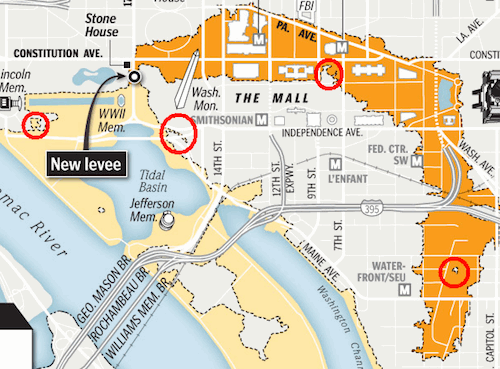The Washington Post featured an interesting map of the 100-year flood plain in the vicinity of the National Mall in Washington, DC, accompanying the article, Flood plan proposed to protect Washington Mall. It discusses a construction project that’s just about underway. When completed, it will keep a large crescent of land dry if the Potomac River spills its banks in particularly dramatic fashion.

This effort will create a levee across a small portion of 17th Street that serves as a chokepoint. The city would drop aluminum panels into place across the roadway to complete the levee if water ever started creeping towards the Mall. The Potomac River generally rises slowly so there should be plenty of warning.
I found a couple of things particularly interesting: the existence of such a tiny neck along 17th Street that would become a gateway to widespread flooding if left to natural tendencies; and the dramatic differences that minor variations in topography would make within the National Mall area. Much of the land here was created artificially and it has little elevation to begin with (notice the differences in the graphic I have at the top of the blog from a much earlier time).
I also spotted several small anomalies in the pattern that I decided to explore further. I’ve circled them in red on the map and I will explore them each from west to east.
Korean War Veterans Memorial Knob

A curious knob protrudes immediately to the southeast of the Lincoln Memorial (map). Roughly, it encompasses the boundaries of the Korean War Veterans Memorial. Apparent the surrounding land must have been excavated into the shape of a shallow bowl. I’ll have to keep my eyes open for that the next time I visit. A 100-year flood would fill the bowl while leaving immediately adjacent lands dry.
Maine Avenue Sluice
This portion of the floodplain just south of the Washington Monument juts out like a narrow finger. Google Street View provides a ready explanation. Earthen berms have been constructed on either side of Maine Avenue. Rising waters would travel straight down the roadway like a sluice, unable to breach the barriers corralling it. Take a closer look — these are hardly remarkable changes in elevation. Nonetheless it would make all the difference between wet and dry.
Dry at the National Gallery of Art

Levee or not, one corner of the National Mall above Madison Drive has nothing to fear (map). Once again the hand of man expressed itself upon this heavily altered terrain, creating winners and losers. While the Korean War Veterans Memorial was built into a bowl and would flood, the topography of National Gallery of Art Sculpture Garden includes a slight swell and would remain dry.
Head for the Hill!
There wouldn’t be any problems along the floodplain crescent if the levee worked, but what if it failed? Then my favorite little anomaly would become a vitally important life raft. A small dry dot would remain above the disaster just east of the Waterfront/SEU metro subway station.
Run directly towards that minor hilltop! It’s very obviously a man-made feature and it doesn’t seem to serve any purpose other than aesthetic. Nonetheless it would become a nice little island refuge in a 100-year flood. I suppose one could also run a couple blocks to the east or west but that wouldn’t be nearly as much fun.

Leave a Reply